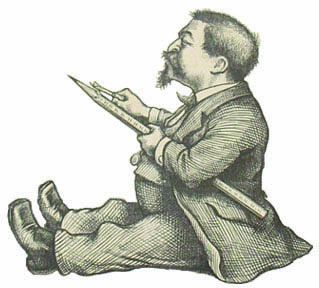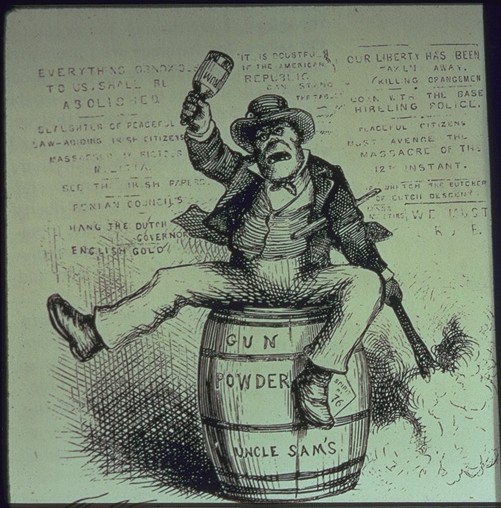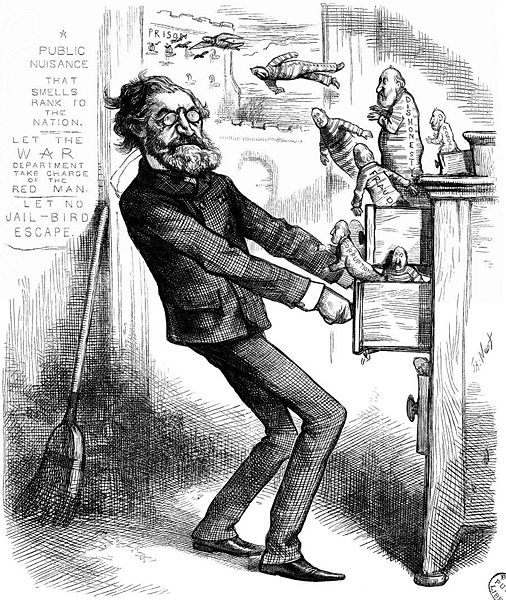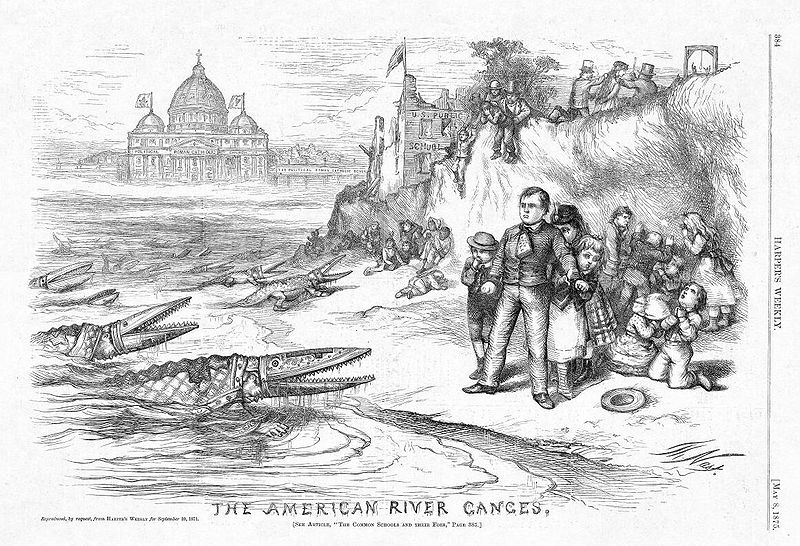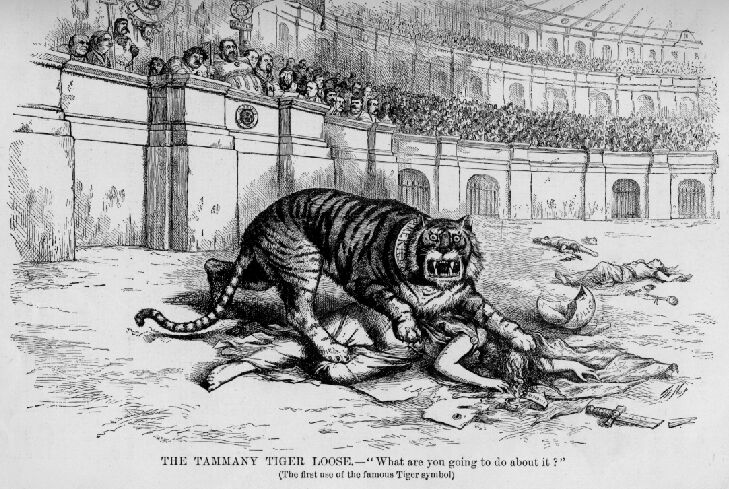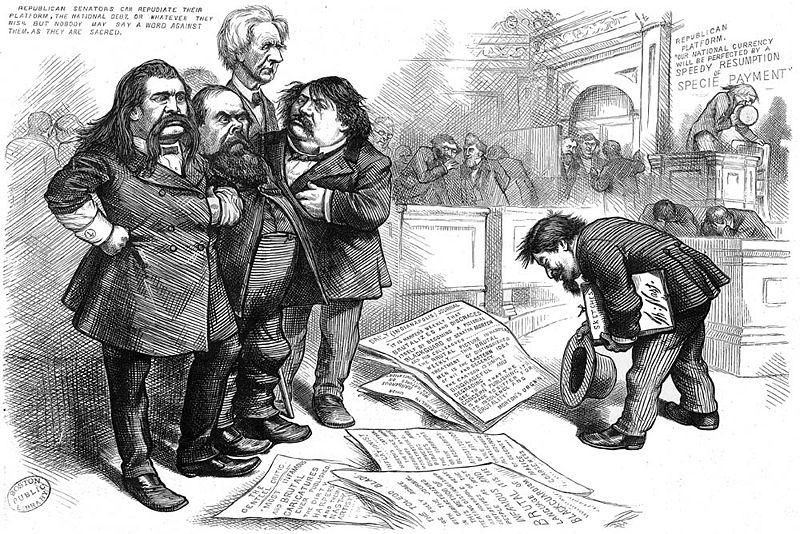<Back to Index>
- Mathematician Hans Hahn, 1879
- Cartoonist Thomas Nast, 1840
- Priore of the Republic of Florence Còsimo di Giovanni degli Mèdici, 1389
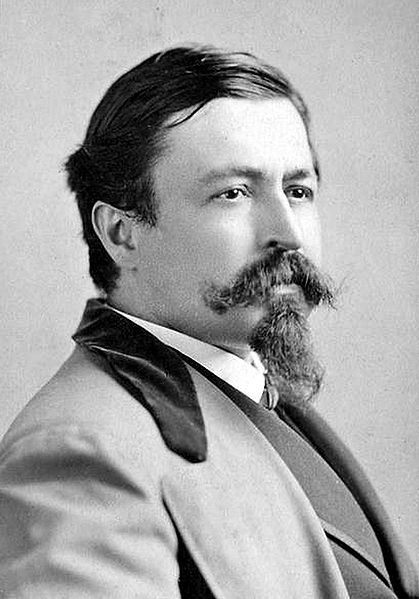
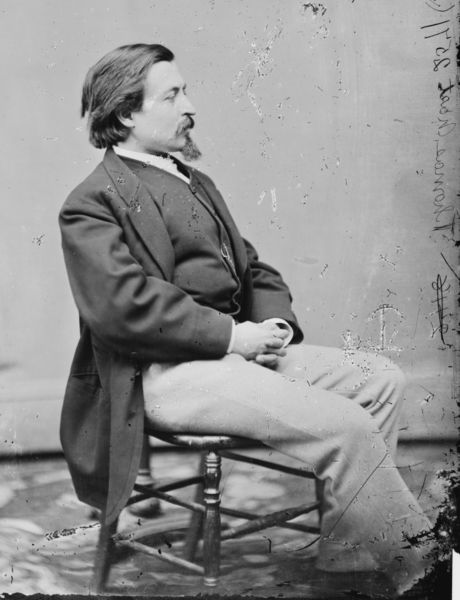
Thomas Nast (September 27, 1840 – December 7, 1902) was a German-born American caricaturist and editorial cartoonist who is considered to be the "Father of the American Cartoon."
He was born in the barracks of Landau, Germany (in the Rhine Palatinate), the son of a trombonist in the 9th regiment Bavarian band. The elder Nast's socialist political convictions put him at odds with the German government, and in 1846 he left Landau, enlisting first on a French man-of-war and subsequently on an American ship. He sent his wife and children to New York City, and at the end of his enlistment in 1849 he joined them there. Thomas Nast's passion for drawing was apparent from an early age, and he was enrolled for about a year of study with Alfred Fredericks and Theodore Kaufmann and at the school of the National Academy of Design. After school (at the age of 15), he started working in 1855 as a draftsman for Frank Leslie's Illustrated Newspaper; three years afterwards for Harper's Weekly.
Nast drew for Harper's Weekly from 1859 to 1860 and from 1862 until 1886. In February 1860 he went to England for the New York Illustrated News to depict one of the major sporting events of the era, the prize fight between the American John C. Heenan and the English Thomas Sayers sponsored by George Wilkes, publisher of Wilkes' Spirit of the Times. A few months later, as artist for The Illustrated London News, he joined Garibaldi in Italy. Nast's cartoons and articles about the Garibaldi military campaign to unify Italy captured the popular imagination in the U.S. In 1861, he married Sarah Edwards, whom he had met two years earlier.
His
first serious works in caricature was the cartoon "Peace," (made in
1862) directed against those in the North who opposed the prosecution
of the American Civil War. This and his other cartoons during the Civil War and Reconstruction days were published in Harper's Weekly. He was known for drawing battlefields in border and southern states. These attracted great attention, and Nast was called by President Abraham Lincoln "our best recruiting sergeant". Later, Nast strongly opposed President Andrew Johnson and his Reconstruction policy. Nast's drawings were instrumental in the downfall of Boss Tweed, the powerful Tammany Hall leader.
As commissioner of public works for New York City, Tweed led a ring
that, by 1870, had gained total control of the city's government, and
controlled "a working majority in the State Legislature". Tweed and his associates — Peter Barr Sweeny (park commissioner), Richard B. Connolly (controller of public expenditures), and Mayor A. Oakey Hall — defrauded
the city of many millions of dollars by grossly inflating expenses paid
to contractors connected to the Ring. Nast, whose cartoons attacking
Tammany corruption had appeared occasionally since 1867, intensified
his focus on the four principal players in 1870 and especially in 1871. Tweed
so feared Nast's campaign that an emissary was sent to offer Thomas
Nast a large bribe, which was represented as a gift from a group of
wealthy benefactors to enable Nast to study art in Europe. Feigning interest, Nast bid the initial offer of $100,000 dollars up to $500,000 before declaring, "I don't think I'll do it". Nast
pressed his attack, and an indignant public rose against the Ring,
which was removed from power in the election of November 7, 1871. Tweed
was arrested in 1873 and convicted of fraud. When Tweed attempted to
escape justice in December 1875 by fleeing to Cuba and from there to
Spain, officials in Vigo, Spain, were able to identify the fugitive by using one of Nast's cartoons. Nast
believed that the well-organized Irish immigrant communities in New
York had provided the basis for Tweed's popular support. Because of
this — along with Nast's Anti-Catholic and Nativist beliefs — Nast often portrayed the Irish immigrant community, and Catholic Church leaders, with extreme prejudice. In 1871, one of his works, titled "The American River Ganges", infamously portrayed Catholic bishops as crocodiles waiting to attack American school children. Nast's anti-Irish sentiment is apparent in his characteristic depiction of the Irish as violent drunks, often with ape-like features.
In general, his political cartoons supported American Indians, Chinese Americans and advocated abolition of slavery. Nast also dealt with segregation and the violence of the Ku Klux Klan,
which was detailed in one of his more famous cartoons called "Worse
than Slavery", which showed a despondent black family having their
house destroyed by arson,
and two members of the Ku Klux Klan and White League are shaking hands
in their mutually destructive work against black Americans. His
cartoons frequently had numerous sidebars and panels with intricate
subplots to the main cartoon. A Sunday feature could provide hours of
entertainment and highlight social causes. His signature "Tammany
Tiger" has been emulated by many cartoonists over the years, and he
introduced into American cartoons the practice of modernizing scenes
from Shakespeare for a political purpose. Harper's Weekly, and Nast, played an important role in the election of Ulysses Grant in 1868 and 1872; in the latter campaign, Nast's ridicule of Horace Greeley's
candidacy was especially merciless. Nast became a close friend of
President Grant and the two families shared regular dinners until
Grant's death. Nast encouraged the former president's efforts in
writing his autobiography while battling cancer. He moved to Morristown, New Jersey in
1872 and lived there for many years. In 1873, Nast toured the United
States as a lecturer and a sketch-artist, as he would do again in 1885
and 1887. He shared political views with his friend Mark Twain and was for many years a staunch Republican. Nast opposed inflation of the currency, notably with his famous rag-baby cartoons, and he played an important part in securing Rutherford B. Hayes’ presidential election in 1876. Hayes later remarked that Nast was "the most powerful, single-handed aid [he] had", but
Nast quickly became disillusioned with President Hayes, whose policy of
Southern pacification he opposed. He was not given free rein to attack
Hayes in Harper's, however; with the death of Fletcher Harper in
1877, Nast lost an important champion at the journal, and his
contributions became less frequent. He focused on oil paintings and
book illustrations, but these are comparatively unimportant.
In 1884, his advocacy of civil service reform and his distrust of James G. Blaine, the Republican presidential candidate, forced him to become a Mugwump, whose support of Grover Cleveland helped
him to win election as the first Democratic president since 1856. In
the words of the artist's grandson, Thomas Nast St Hill, "it was
generally conceded that Nast's support won Cleveland the small margin
by which he was elected. In this his last national political campaign,
Nast had, in fact, 'made a president.'" Nevertheless, Nast's tenure at Harper's Weekly ended with his Christmas illustration of December 1886. In the words of journalist Henry Watterson, "in quitting Harper's Weekly, Nast lost his forum: in losing him, Harper's Weekly lost its political importance." In 1890, he published Thomas Nast's Christmas Drawings for the Human Race. He contributed cartoons in various publications, notably the Illustrated American, but with the advent of new methods and younger blood his vogue was passed. In 1892, he took control of a failing magazine, the New York Gazette, and renamed it Nast's Weekly. Now returned to the Republican fold, Nast used the Weekly as a vehicle for his cartoons supporting Benjamin Harrison for president, but the magazine had little impact and ceased publication shortly after Harrison's defeat. In 1902 Theodore Roosevelt appointed him as the United States' Consul General to Guayaquil, Ecuador, in South America.
During a deadly yellow fever outbreak, Nast stayed to the end helping
numerous diplomatic missions and businesses escape the contagion. At
age 62, in 1902, he died of yellow fever contracted there. His body was returned to the United States where he was interred in the Woodlawn Cemetery in The Bronx, New York.
